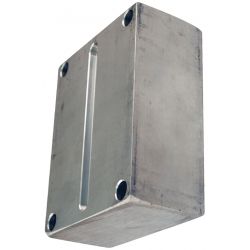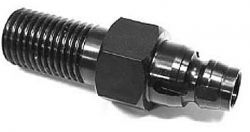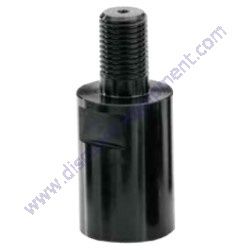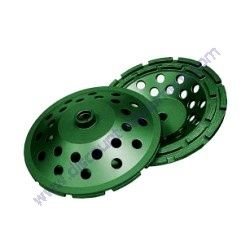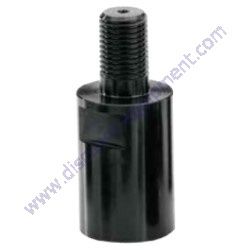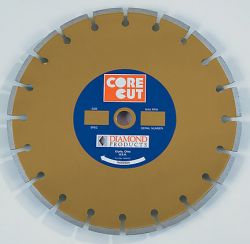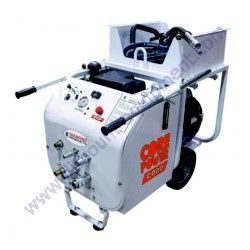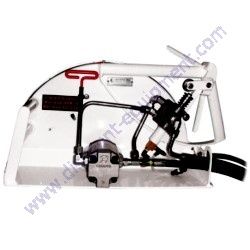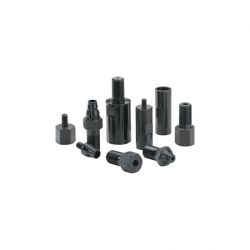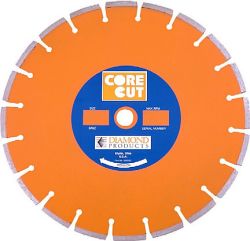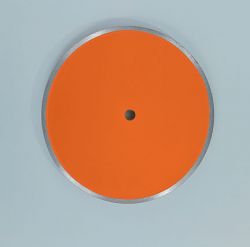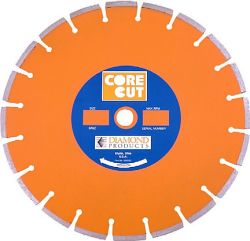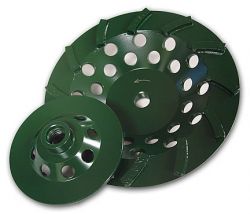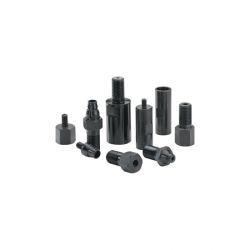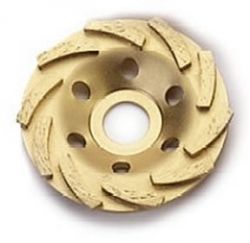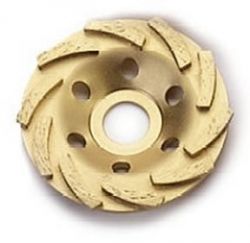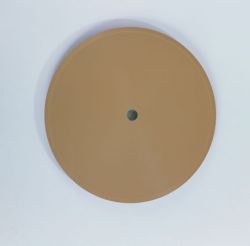Diamond Products 5801345 Saw, Walk Behind First-Cut W/6" Guard, Gas 4.8HP Honda GX160 CC148HXL-EE6 c/n 32739
Safety Information
Diamond Products CC150XL-EE First Cut Walk Behind Concrete Saw
SAFETY PRECAUTIONS
Safety
Operate the equipment and all of its components according to this manual. Failure
to comply with and understand the following safety, operation and maintenance instructions can result in serious injuries and/or death. All operators must be properly trained or supervised by experienced personnel prior to using this saw and should understand the risks and hazards involved. Diamond Products discourages improper or unintended equipment usage and cannot be held liable for
any resulting damages.
Equipment modifications should be made by Diamond Products to ensure safety and
design. Any modifications made by the owner(s) are not the responsibility of Diamond Products and void all equipment warranties if a problem arises as a result of the modification.
Refer to the Diamond Products Parts List for additional information and part diagrams. Refer to the motor manufacturer as the primary source for all safety, operations, and maintenance instructions regarding the motor.
Prior to operating, record the saw’s serial number, and the motor’s model and serial numbers in Appendix D.
Notice: The information in this manual may be updated at any time!
Safety Alerts
DANGER
Serious injuries and/or death will occur if these instructions are not followed.
WARNING
Serious injuries and/or death could occur if these instructions are not followed.
CAUTION
Mild and/or moderate injuries could occur if these instructions are not followed.
PROPOSITION 65
WARNING: Concrete cutting produces dust that can expose you to chemicals including Silica, crystalline (airborne particles of respirable size), which is known to the state of California to cause cancer. For more information go to:
WWW.P65WARNINGS.CA.GOV
Respiratory Hazards
WARNING
Concrete cutting produces dust and fumes known to cause illness, death, respiratory disease, birth defects, and/or other reproductive harm. Safety protection techniques include, but are not limited to:
• Wearing gloves.
• Wearing safety goggles or a face shield.
• Using approved respirators.
• Washing work clothes daily.
• Using water when wet cutting to minimize dust.
• Washing the hands and face prior to eating/drinking.
For additional safety and self-protection information contact your employer, the
Occupational Safety and Health Administration (OSHA), and/or The National
Institute for Occupational Safety and Health (NIOSH).
General Safety
• Read and understand all safety, operations, and maintenance instructions
provided in this manual prior to operating or servicing the saw.
• Keep equipment components clean and free of slurry, concrete dust, and debris.
• Inspect water hoses prior to operating the equipment. Clean, repair, or replace
damaged components.
• Raise the equipment to a proper height for access when working underneath the
equipment. Use chocks to block the wheels, and fit blocks or jacks under the
frame edges.
• When using a jack to raise the equipment, place the jack against a solid, flat area under the frame base to properly support the equipment.
• Repair the equipment immediately when a problem arises.
• Replace equipment decals if unreadable.
• Dispose of all hazardous waste materials according to city, state, and federal
regulations.
• Always have a phone nearby, and locate the nearest fire extinguisher and first aid kit prior to operating the equipment.
• Operate the equipment wearing flame resistant clothing.
• Always wear safety glasses when removing retaining rings.
• Underage or non-trained personnel should not operate the equipment.
• Keep all body parts away from rotating machinery.
• Replace all guards and access panels (unless stated otherwise) prior to operating the equipment.
DO NOT:
• Assume the equipment will remain still when parking/stopping the equipment on a
slope. Chock the wheels to help prevent unnecessary movement.
• Drop equipment, supplies, tools, etc., when handling to help prevent injuries.
• Lift and carry equipment, supplies, tools, etc., that are too heavy and/or cannot be lifted easily.
• Operate the equipment without using the appropriate safety equipment required
for the work task.
• Operate or service the equipment with any clothing, hair, or accessories that can snag in the machinery, which could lead to serious injuries or death!
• Operate the equipment using attachments not associated with or recommended for
the equipment.
• Operate the equipment around combustible materials.
• Operate the equipment with anyone near the work area or within the direct line of the blade.
• Operate the equipment until all unnecessary materials have been removed from the work area.
• Operate the equipment with loose nuts, screws, and bolts.
• Operate the equipment when ill or fatigued.
• Operate the equipment under the influence of drugs and/or alcohol.
• Operate the equipment on steep slopes.
• Cut concrete with guards and access panels removed.
• Grease the equipment with the engine/motor running.
• Touch hot components when operating the equipment.
• Leave the equipment unattended until the engine/motor is off and the blade has
stopped.
• Place the equipment into storage until it has cooled down.
• Service the equipment until it has cooled down.
• Service the equipment with the engine/motor running.
Blade Safety
• Always use reinforced abrasive blades or steel-centered diamond blades.
• Inspect all blades prior to usage and discard damaged blades.
• DO NOT install or remove a blade with the engine/motor running.
• Keep all body parts away from rotating blades.
• Inspect the blade flanges for damages, wear, and cleanliness. Clean or replace
dirty/damaged components immediately.
• DO NOT expose yourself or anyone else to the direct line of the blade when operating the equipment.
• Always use an appropriate size blade and the correct blade type based on the cutting task and the type of material being cut.
• The blade must always fit snug on the blade shaft, outer flange, and/or inner
flange.
• Wear gloves and be alert to the surrounding environment when handling blades.
• When installing the blade, always point the arrow printed on the blade in the direction of the blade shaft’s rotation.
• DO NOT exceed the blade’s maximum recommended speed when cutting.
Excessive blade speeds can cause blade breakage, resulting in serious injuries
and/or death!
• DO NOT use damaged blades when cutting to avoid harming yourself, others, or
the equipment.
• DO NOT use a blade for cutting that requires a lower speed than the blade shaft
speed.
• Always tighten the blade shaft flange nut as directed to properly secure the outer flange and blade. Failure to properly secure the outer flange and blade may cause parts to loosen or fall off the equipment, resulting in serious injuries or death!
• Let the blade cool prior to removal.
• Inspect the skid plate for damage, wear, and cleanliness. Clean or replace
dirty/damaged components immediately.
Spring Box Safety
• DO NOT operate the equipment with the spring box removed.
• Blade exposure should not exceed 180° while cutting.
• DO NOT install or remove the spring box with the engine or motor running.
Fuel Safety
• Always use caution when refueling.
• Store all fuel in appropriate safety containers.
• DO NOT operate the saw with a fuel leak.
• DO NOT fuel the saw with the engine running.
• Let the engine cool prior to adding fuel.
• Refer to the engine manual for recommended fuels.
• Always use appropriate fuels in cold weather.
• Move the saw away from the refueling area prior to starting the engine.
• DO NOT smoke or expose fuel to open flames when filling the fuel
tank or working with fuel.
• Clean up any spilled fuel prior to starting the engine.
• Drain the fuel tank and fuel lines when storing the saw for longer periods of time.
Refer to the engine manual for additional recommendations.
• Fuel may seep out from the fuel cap vent (applicable models) when raising the saw if the fuel tank has been overfilled.
Engine/Motor Safety
• Refer to the engine/motor manual as the primary source for engine/motor safety.
• Always know how to turn off the engine/motor quickly for emergency purposes.
• Make sure the speed control lever (applicable models) is at Neutral when
starting the engine/motor.
• Fill the fuel tank and check the oil level prior to starting the engine.
• Keep all body parts away from rotating saw parts with the engine/motor running.
• DO NOT start the engine without the air filter(s) installed.
• DO NOT allow dust to enter the air intake tube when cleaning/replacing air filter(s).
• Replace damaged components immediately that may allow dust to enter the engine.
• DO NOT leave the engine/motor running unattended.
Always operate the saw in well ventilated areas. Concentrated engine exhaust can cause loss of consciousness and/or death.
• DO NOT touch the engine/muffler assembly with the engine running, and always let them cool down prior to touching or servicing the saw.
• Handle hot oil carefully when changing the oil.
• Wipe down the engine/motor exterior and guards daily or regularly to prevent high operating temperatures. DO NOT spray the engine/motor with water to prevent
engine/motor damage.
• Let the engine cool prior to removing pressurized caps (applicable models).
• All electric motor saws should be properly grounded prior to operating.
• DO NOT supply less or more power to the electric motor saw than what the motor is rated for.
Cutting Safety
• The direct work area should not contain buried or embedded electrical, gas, or
water lines that could be damaged and/or cause personal injury while cutting.
• Turn off all electricity, gas, and water around the direct work area prior to cutting.
• Inspect the work area to ensure nothing will impede full control of the machine at all times.
• DO NOT expose yourself or anyone else to the direct line of the blade when operating the equipment.
• DO NOT allow any person, animal, and/or objects in and around the work area while cutting.
• DO NOT install a blade on the machine until it is in the cutting area.
• Ensure the work area is adequately illuminated to ensure safe operation of the
machine.
Belt Safety
• Turn off the engine/motor and let the belt cool down prior to servicing it.
• Regularly inspect the belt for fraying, stress cracks, and/or breakage and replace immediately when damaged. Always check the belt alignment prior to operating the equipment.
• Use extreme caution when working with belts and rotating machine parts to avoid
entanglement.
• Over-tensioning the belt may reduce the life of the blade shaft bearings. Under tensioning the belt may cause slippage, shorter belt life, and/or poor equipment
performance.
• Squealing belts indicate looseness. Transporting Safety
• Remove the blade prior to transporting the equipment.
• Chock the wheels and secure the saw in the truck/trailer prior to transporting.
• Refer to the Department of Transportation (DOT) for additional transportation
recommendations.
Lifting Safety
• Move yourself and all others away from the lifting area when hoisting the saw to prevent being crushed.
• Secure the appropriate hoisting cables, straps, and/or chains to the saw’s
designated lift points prior to hoisting.
• DO NOT attempt to lift the saw irresponsibly and/or improperly.
|

